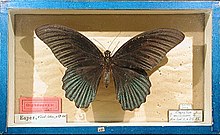Eugen Johann Christoph Esper
Eugen Johann Christoph Esper (born June 2, 1742 in Wunsiedel , † July 27, 1810 in Erlangen ), also called Eugenius Johann Christoph Esper , was a German entomologist , botanist , pathologist and mineralogist . Its official botanical author's abbreviation is " Esper ".
Live and act
Esper and his brother Johann Friedrich Esper (1732–1781) were introduced to natural history at an early age by their father Friedrich Lorenz Esper , a great nature lover and botanist . Casimir Christoph Schmidel (1718–1792), professor of botany, advised Eugen Esper to abandon his theology studies and instead study natural history with him.
He received his doctorate in philosophy at the University of Erlangen in 1781 with the thesis De varietatibus specierum in naturæ productis . From the following year he taught there first as professor extraordinary, then from 1797 as professor full philosophy. From 1805 he headed the Department of Natural History at the University of Erlangen. Thanks to his work, the collections of minerals, birds, plants, shells, and especially those of insects at the university grew very quickly.
In his spare time, Esper devoted himself to studying nature and preparing his manuscripts on natural history . He was the author of a series of books and monographs, such as The Butterflies in Pictures from Nature with Descriptions (1776–1807), following the Linnaeus system . These were richly illustrated: minerals, birds, plants, shells and insects on 438 colored hand-drawn panels. Toussaint von Charpentier (1779–1847) brought out a second edition from 1829 to 1839. It also contains first descriptions of butterflies from the Johann Christian Gerning collection , which is in the Wiesbaden Museum and contains items from the collection of Maria Sibylla Merian (1647–1717).
Esper was also the first to research paleopathology and is considered to be the founder of this important branch of pathology . In 1789 he was elected a member of the Leopoldina .
Works
- The butterflies in illustrations after nature with descriptions. Walther & Weigel, Erlangen, Leipzig 1777–1839 post mortem doi: 10.5962 / bhl.title.15535
- De varietatibus specierum in naturæ productis. Erlangen 1781.
- Ad audiendam orationem. Erlangen 1783.
- Natural history in the extract of the Linneischen system, with explanation of the artificial words. Nuremberg 1784.
- The plant animals in images of nature, illuminated with colors, together with descriptions. Raspe, Nuremberg 1791-1830 post mortem
- Icones fucorum. ... illustrations of the Tange. Raspe, Nuremberg 1797-1818 pm
- Textbook of mineralogy. Palm, Erlangen 1810.
- The foreign butterflies in pictures after nature . Erlangen, published by the expedition of the Esper butterfly and the Schreber mammal factory, [1830] doi: 10.5962 / bhl.title.12489
literature
- Florian Heller: Esper, Eugen Johann Christoph. In: New German Biography (NDB). Volume 4, Duncker & Humblot, Berlin 1959, ISBN 3-428-00185-0 , p. 655 ( digitized version ).
- Hermann Hacker: Esperiana. (Vol. 6) Delta & Peks, Schwanfeld 1998.
- Wilhelm Gottlieb Rosenhauer: Esper, Eugen Johann Christoph . In: Allgemeine Deutsche Biographie (ADB). Volume 6, Duncker & Humblot, Leipzig 1877, p. 376.
Web links
- Author entry and list of the described plant names for Eugen Johann Christoph Esper at the IPNI
| personal data | |
|---|---|
| SURNAME | Esper, Eugen Johann Christoph |
| ALTERNATIVE NAMES | Esper, Eugenius Johann Christoph |
| BRIEF DESCRIPTION | German entomologist, botanist, pathologist and mineralogist |
| DATE OF BIRTH | June 2, 1742 |
| PLACE OF BIRTH | Wunsiedel |
| DATE OF DEATH | July 27, 1810 |
| Place of death | gain |

